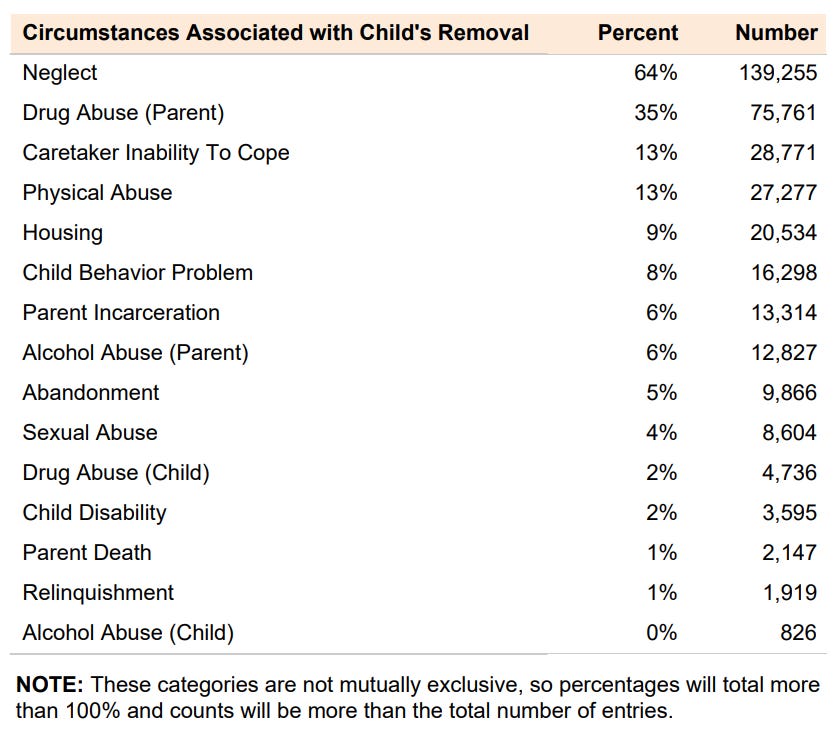#011: Putting fewer kids in foster care
Feat. Extreme Temperatures, Hero Rats, and Haboobs
The IdeaList is a newsletter exploring social issues and ideas for making the world a better place.
Subscribe for free to stay up to date and support my work.
In This Edition (7 minute read)
How we might actually put too many kids in foster care due to the murkiness of ‘child neglect’
The Idea List, which explores names for heat waves, cold waves (?), rats with backpacks, nuclear reactors in space, and medical debt
A haboob on video

I’ll probably write multiple posts on child welfare because it’s so important and yet seemingly so overlooked. Negative childhood experiences are costly to the child, but they’re also costly to society because they can cascade into other social problems. For example, childhood abuse increases a child’s future risk of physical and mental health problems, homelessness, and involvement in the criminal justice system. Kids are the future of our society, so we should be making strong investments in the safety, health, and education of our kids. Unfortunately, many of our systems for child welfare leave much to be desired.
This post is about the foster care system, which is supposed to care for kids who can’t live with their families because of abuse, neglect, incapacitation, or abandonment. According to the most recent federal data, there are 407,000 kids in foster care. From October 2020 to September 2021, 216,000 kids entered foster care; and 224,000 exited foster care, with 62% having spent over a year in the system.
A foster home shortage creates further trauma for foster kids
The kids who touch this system have experienced immense loss and trauma already, and most of them will stay in the system for an extended length of time. It should be the duty of our foster care system to provide a safe home during this difficult period, but a foster home shortage means that many foster kids will only face further trauma in foster care. They’ll be separated from their siblings, placed in group homes and institutions, and spend time miles away from loved ones. The situation is worse for many others: with no homes for incoming kids, foster care agencies across the country have been forced to send kids out of state or put kids in hotels and on office building floors.
As I’ve learned more about the foster care system, I’ve struggled to wrap my head around the fact that we’re willing to take a child from their supposedly unsafe home, only to put them into a system that clearly struggles to give them a much better place to stay. Of course, I don’t mean to suggest that we shouldn’t remove children from their families when they’re brutally abused. It’s just that many foster kids are removed for much less. There is a foster home shortage, it’s causing bad experiences for foster kids, and we need to fix it. But what if that shortage is being amplified because we’re taking too many kids away from their families?
A lot of kids are removed from their families for ‘neglect only’
It turns out that many foster kids are removed from their families because of neglect, not abuse; and it’s neglect that’s at the root of my question. According to the Children’s Bureau, there were 656,000 victims of child maltreatment in 2019. Of those victims, 62% didn’t face physical, sexual, or psychological abuse at all; they were victims of neglect only. While only about a quarter of child maltreatment victims will end up in foster care, a report on foster children tells a similar story about neglect among foster child removal reasons. The chart below details removal reasons for kids entering care between September 2020 and October 2021.
As you can see, physical and sexual abuse are associated with 13% and 4% of removals, respectively, while neglect is associated with 64% of removals. We have to be careful because the categories overlap, meaning that some of the 64% could be neglect and another removal reason. Still, neglect is so prevalent that it’s likely the main removal reason for a sizable number of foster children.
What if many ‘neglect only’ cases shouldn’t result in removal?
The definition of child neglect differs by state, but it generally refers to a failure to provide certain needs of the child, like food, clothing, shelter, medical attention, and education. Obviously, we want to make sure children have their basic needs met, but the response needs to be appropriate. Definitionally, child neglect overlaps with child poverty quite a bit, and my worry is that many instances of “child neglect” should not result in a removal. It’s one thing if a parent is willfully refusing to care for their child, but it’s another if a parent is trying and needs help. For a family in the latter category, the problem would be solved by providing the help, not taking away the child.
Removals don’t come without costs; (1) they inflict trauma on the child by separating them from their family and (2) they require the foster care system to find a place for them to stay. If we’re removing kids that don’t need to be removed, we’re traumatizing kids for no reason and putting stress on a system that’s already busting at the seams.
If I were king, I would call for an audit of all child removals for neglect only. My goal would be to understand how many of these cases are justified. The audit may find that the system makes good decisions most of the time; maybe we already provide families with resources to prevent removals and remove kids only in serious cases. Or it could find that 40,000 child removals each year could be eliminated by giving families food, clothes, and shelter. With the reduction in foster kids overall, maybe we’d do a better job placing the foster kids we do have, instead of putting them in hotels and on office building floors.
The Idea List
🥵 Name heat waves so that people take them more seriously
Heat waves are happening more and more these days. When you think of dangerous weather, you might not think of heat waves, but apparently they’re responsible for the most yearly deaths of any weather category in the United States. Naming them could bring more public attention to an overlooked weather category.
This study estimates about 1.7 million deaths globally from extreme heat and cold in 2019, but 1.4 million were related to the cold. Weirdly, the entire article and almost all of the press on extreme temperature deaths is about the heat. Clearly, extreme heat is dangerous, but are we overlooking a bigger problem because it doesn’t fit within the narrative of climate change and increasing temperatures?
🐀 Train rats to find earthquake survivors
This program straps backpacks with location trackers and microphones on rats so that search-and-rescue teams can find survivors under earthquake rubble. The article gave me a new appreciation for rats, which are also being trained to sniff out diseases and find landmines.
🚀 Launch nuclear reactors into space
Finding better power sources for our spacecraft will be crucial to long-distance space travel and long-term human presence on other planetary bodies. Apparently, nuclear power is one of the more promising alternative fuel sources for space, but regulation has held it up for decades (In the 1980s, a Soviet nuclear reactor de-orbited and sent radioactive debris over Canada). A new directive made it possible for a startup called Atomos Space to test their reactor in orbit, which could serve as a proof-of-concept for regulatory-safe nuclear power in space.
👨⚕️ Shed light on the devastating effects of medical debt
Medical debt puts financial stress on families and blocks patients from getting the care they need. Our nation has a healthcare cost problem, and this article sheds some light on the devastating implications. According to the poll, 63% of adults with medical debt cut spending on food, clothing, and other basics due to their debt; 48% used up all or most of their savings; and 17% declared bankruptcy or lost their home.
One Last Thing: Haboobs
This month, I learned that New Mexico has these things called haboobs, which are basically giant dust storms with a hilarious name. They’re incredibly scary-looking, but apparently you can drive through them and not die. Here’s a video of a “monster, epic haboob.” At around 2:20, they drive around inside of it. At around 4:00, you can watch a time lapse of the haboob moving straight over a town.
Until next time,
Noah
Previous Editions
If you liked this edition, you might like a past edition:
You can also check out all previous editions of The IdeaList to read about other big social issues and ideas for making the world a better place.

